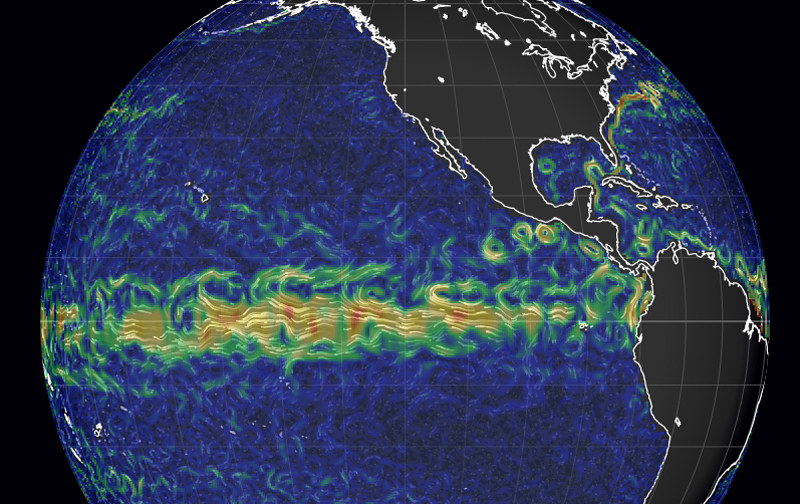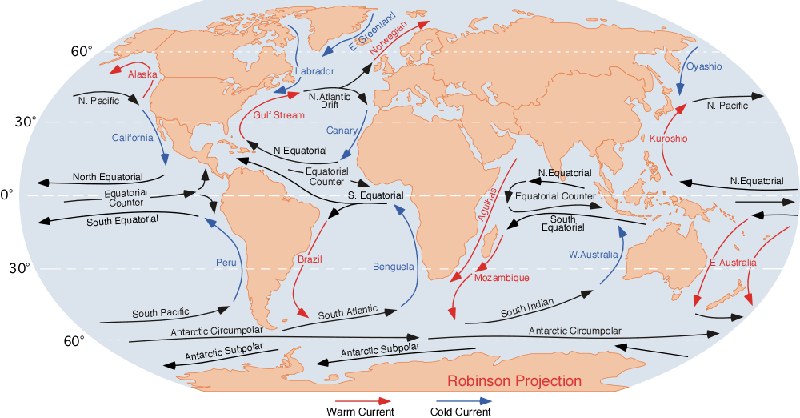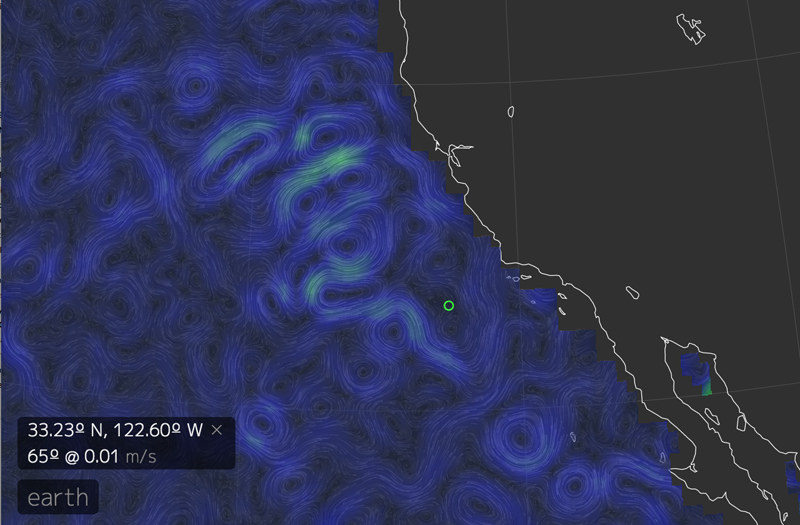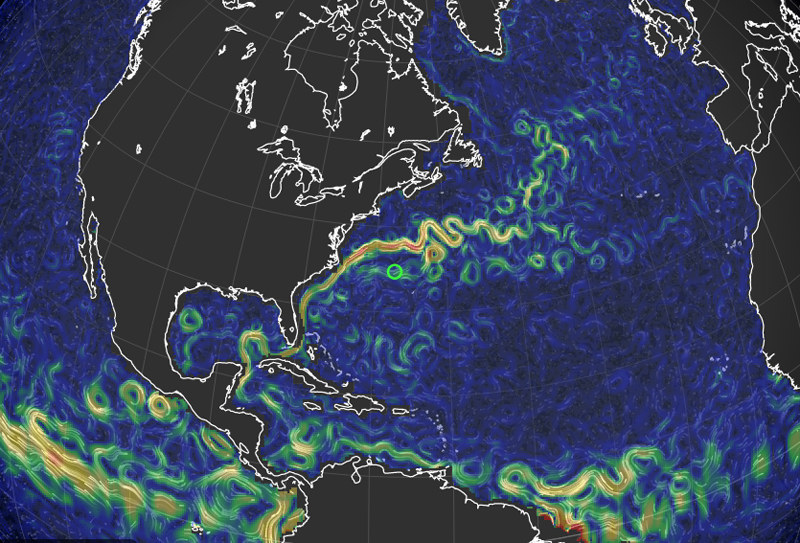
Mindboggling Worldwide Currents

We recently reported on the development of the Earth Wind Map, which is one of the most fascinating depictions of natural phenomena that we’ve ever seen. If you haven’t checked it out yet you should, as it gives a graphical interpretation of air currents everywhere on earth, with the imagery updated every three hours.
What’s next? We’ve just been alerted that a similar depiction of worldwide currents has also been developed — apparently by the same group of scientists. As with the Earth Wind Map, currents are laid over a Google-Earth-style line drawing of planet Earth. With your mouse, you can spin the globe to see any spot on the planet, then zoom in for more detail by double-clicking. More subtle currents are depicted as green lines, and stronger currents are shown as yellow and orange lines.

If the data is to be believed, there is currently a weak northbound current between Point Conception and San Francisco Bay. And check out the power of the Gulf Stream traveling north from the Caribbean along the Eastern Seaboard. The volume of warm water pushing west gives weight to the theory that the British Isles, which lie between latitudes 50 and 59 degrees N, would not be habitable if the flow of the Gulf Steam shut off.

In the March edition of Latitude 38 magazine we hope to bring you details on how this data is collected and how it is converted to this amazing graphic display.

Google Barge to Move
The mysterious, four-story Google barge, currently under construction at Treasure Island, must move. While investigating numerous complaints against the facility the San Francisco Bay Conservation and Development Commission (BCDC) found it was lacking the proper permits.
Although this is not necessarily Google’s fault, the city of San Francisco (which owns Treasure Island) and the Treasure Island Development Authority each failed to apply for and thus produce the permits allowing this type of construction at the island.
Google will have to move the barge to a facility that is permitted for construction of this nature. There is still a slim possibility that the city of San Francisco and the Authority can comply with BCDC’s permit requirements, but according to BCDC’s Executive Director Larry Goldzband, "it needs to move."
Google has described the barge, "as an interactive space where people can learn about new technology." It will be interesting to see where the barge ends up, because you can’t just park it anywhere on San Francisco Bay. Stay tuned.
More Impounded Boats “Liberated” in Mexico
Jonathan Cervantes, the very helpful harbormaster at Cruise Port Marina in Ensenada, reports that all but about "nine or 10" of the 42 mostly foreign-owned boats that were impounded at his marina since late November have now been "liberated." He is unclear why the remaining boats — which include one dinghy — have not been released. He suspects it may be because the owners of those boats hired lawyers and/or went to the AGACE offices in Tijuana on their own, and thus weren’t part of the main group of boats AGACE apparently decided to process first. Cervantes believes the remaining boats — including the dinghy — are "fine and will be released soon."
"The AGACE inspectors didn’t know anything about boats when they arrived unannounced in November," Cervantes told Latitude in a telephone interview yesterday. "For example, they were looking for one specific type of TIP (Temporary Import Permit) form. When they were confronted with older ones that were still valid, they initially assumed they were fake."
Auditors were also confused when they inspected a now-New Zealand-owned boat that had been bought in California and still had the US documentation number in the hull. The New Zealand registration number didn’t match the documentation number carved in the hull. Totally confused, the auditors decided to impound the boat and clarify things later. When in doubt, impound, was the AGACE rule. Alas, AGACE would take more than two months to clear up their doubts.
We know that it’s hard for most readers to appreciate how poorly conceived and executed this AGACE audit was, but here is just another example from Cervantes of how weird it got. Some boat owners who went to the AGACE offices in Tijuana to try to get their boats freed were instructed to return to the United States by land and get an official document declaring that their boat was not stolen. Right! What US government agency is going to write an official document like that, particularly one supposedly confirming a negative? Eventually, some AGACE auditors were sent to the United States to get a short course in boat documentation.
"In the future," says Cervantes, "I hope AGACE will be more careful about the nautical tourism industry." Don’t we all?
We also spoke with Fito Espinosa, the equally helpful harbormaster at Marina Coral in Ensenada. He confirmed that 35 of the impounded boats in his marina were released late last week, as reported in ‘Lectronic, leaving another 12 still impounded. Like Cervantes, Espinosa believes that the boats still impounded are those whose owners went to Tijuana to try to get their boats freed, and thus got out of the main liberation process. He believes they will be released before too long.
Curiously, the boats were released from Marina Coral without the marina signing on as a Depositaria for the boats. It’s our understanding that all the other marinas where boat have been released had to sign a paper saying they were Depositarias.
Espinosa confirmed that AGACE officials were confused by the different types of TIPS, as the original ones were for 20 years, newer ones were for 10 years, and even newer ones came with stickers — stickers to be put "on the window closest to the rear view mirror." Because of the confusion, Espinosa recommends that those with old TIPS cough up another $70 or so to get a newer one. Espinosa acknowledges that you can’t get an updated TIP online, and either have to do it at a Mexican consulate in the States or at a Banjercito in Mexico. (We at Latitude know boat owners who have successfully done both. We also know boats with the old 20-year TIPs that have been cleared by AGACE, although this is not a given, as AGACE methods and policies have been wildly inconsistent.)
IMPORTANT! No matter if you apply for a new TIP online or a replacement TIP at a consulate or a Banjercito, Espinosa says you need to understand that when the form asks for the "serial number" of your boat, the form is NOT asking for your boat’s documentation number, but for her HIN (Hull identification number). What to do if you boat is pre-1974 and didn’t have a HIN number, or is a foreign boat that never had a HIN number? Contact the Coast Guard documentation office to get a document which reflects this. As for owners of non-U.S. documented boats with no HIN number, we don’t know what to tell you.
Like all of the harbormasters in Mexico that Latitude has talked to, Cervantes was very complimentary of Latitude‘s coverage. "Latitude‘s explanation of what has been going on has been very precise, and I’ve used it to support my arguments in discussions with Mexican officials." We think calling our coverage "precise" is a bit of a stretch given the lack of explanations and the differing policies and procedures enacted by AGACE, but we think Latitude‘s coverage has been more factual, detailed and nuanced than what has been available elsewhere. We’ve also been tickled to hear harbormasters quote things we’ve said after they appeared in Reforma, the ‘New York Times‘ of Mexico.
At this point it’s unclear how many boats remain impounded in Mexico, but the number has been dwindling quickly. In addition, we’re told that officials in Mexico are trying to come up with a monetary figure of how much damage has been done to nautical tourism. When they do, we suspect there will be strict guidelines established before AGACE attempts any future ‘audits’, if any. As such, we are beginning to believe there indeed will be a 21st Baja Ha-Ha rally starting in late October, and thus we have provisionally accepted a request for a skipper who has done many Ha-Ha’s to be the ceremonial first entry for 2014. She says that her boat will be crewed by an anatomically correct all female crew! Details to come soon. Assuming there will be a 2014 Ha-Ha, entries will be accepted starting May 1.
But before we get too far ahead of ourselves, we want to assure every owner of a boat that’s still impounded in Mexico — such as Rahul Singh’s Challenger 50 Sea Dream — that we have not forgotten you. Please keep us updated of your situation.
